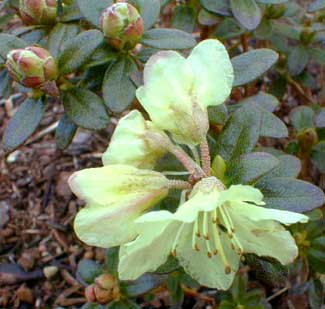
Rhododendron rupicola var. chryseum x ludlowii 'Chikor'
"One's grand flights, one's Sunday baths,
One's tootings at the weddings of the soul
Occur as they occur. So bluish clouds
Occurred above the empty house and the leaves
Of the rhododendrons rattled their gold,
As if someone lived there."
-Wallace Stevens
(1879-1955)
(1879-1955)
Scottish plantsman Peter Cox bred the true-yellow evergreen dwarf rhododendron 'Chikor' by crossing two species rhodies, R. rupicola var chryseum with R. ludlowii. It was named for a Himalayan village, & introduced to the world of gardening in 1962.
Of its parents, R. rupicola is a dwarf rhododendron native to western Chinese mountains. Its species name means 'Dweller Among Rocks.' It normally has purple flowers, as do the majority of dwarf species rhodies, but the variant chryseum has cream-colored to nearly yellow flowers. The other dwarf parent, R. lujdlowii from mountains of southeastern Tibet, provides 'Chikor' its purer primrose-yellow flowers.
The resultant hybrid is so floriferous that the flowers will completely hide the shrub in April. The buds are very colorful in March & the first flowers in display before March's end (as shown in the first photo), but by mid-April the shrub is a little yellow cloud.
There are only a few places in the world where Rhododendron Societies are extreme in their activity, including here in the Pacific Northwest, in New England, & in Scotland. In great part due to Peter Cox of Scotland, the number of dwarf lepidote evergreen rhododendrons available to the world is extensive & increasing.
Although many of the dwarfs Granny Artemis & I possess are pure species shrubs, Cox has been hybridizing for broader color range & to use the alpine lepidotes to increase cold-hardiness of non-alpine shrubs, & using prostrate forms of species shrubs to breed smallish rhodies to be even smaller. I'd love to be able to visit the Cox family nursery's display collection, but I'm not likely ever to be able to travel so far.
Having nearly run out of room in our own gardens for more of these little Asian rhodies, I began planting additional ones in a friend's gardens which I was helping landscape & extend, for there was room for a far more extensive collection. 'Chikor' was among the first of these added, specifically because the yellow lepidotes are so few.
Yellows are more associated with deciduous azaleas but are rare for evergreen rhodies. 'Chikor's' blossoms, in trusses of three to six, may initially appear to be green-tinged yellow, but the interior dorsal blotch is intensely yellow & very showy because the individual flowers have wide open petals. When it reaches full flower it makes a startling pale primrose-yellow impression.
It has a compact, upright, sturdy-twigged tree-like form; indeed, its tiny but tree-like appearance makes it a candidate for further dwarfing as a bonsai plant.
Its green leaves turn bronzy-red in winter which can be a lovely contrast if placed between evergreens that stay green. It needs plenty of light in moist well-draining soil; it will do poorly in shade or in soil that stays too wet.